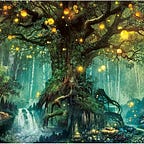Berry Strange Taxonomy
Defining what is (and isn’t) a berry blows the old “Is a tomato a fruit?” question out of the water.
I try to pay attention to the little things when I go for a walk — things I wouldn’t necessarily notice unless I were purposefully looking for them. During my last few outings, the ‘little things’ I’ve recently taken most notice of were tiny, colorful berries that grew on nearby trees and bushes. I’ve seen a variety of these fruits, ranging from plump, rounded sage green berries to clusters of oval, fiery-colored berries. I’m no nature expert, and without a trusty reference book in hand, I didn’t exactly know what berry species I was looking at. So I pulled out the next best source of information I had on me at the time (a.k.a my phone), and did a quick look-up of different berry types. In my search, I soon learned that there’s something even more perplexing than trying to identify the multitudinous species of these tiny fruits: how to define what is — and isn’t — a berry.
The definition of a berry, according to Britannica.com, is “a simple fleshy fruit that usually has many seeds” and “is derived from a single ovary of an individual flower.” Mind you, this is a botanical definition of a berry. Most people, as I imagine, believe that berries are simply any kind of small, fleshy, edible fruit. And if a fruit has the word “berry” in its name (i.e. strawberry, blueberry, etc.), then it’s got to be a berry… right?
Well, not exactly. Take a look at this graphic from an article on McGill University’s website:
As you can see, there are three different categories of berries: common berries, botany berries, and berries that fall under both of these types. And yes, there is a pumpkin and a cucumber included in the botany section of the diagram. If you’re scratching your head, that’s okay; let’s take a closer analysis of the language used to define a berry.
Botanical berries, as mentioned before, come from a single ovary from a single flower. This condition is the real kicker when it comes to identifying a “true berry.” Therefore, fruits like blackberries and raspberries are, despite their name, automatically excluded from the berry family. They’re made up of several little bundles of juice held by a thin surrounding skin, all of which makes up a single unit of fruit. When forming, they’re made from several ovaries, thus they’re technically placed in the aggregate fruit category. Even the strawberry doesn’t sprout from a single ovary, and so it cannot be classified botanically as a berry.
So why are fruits like bananas and oranges considered as berries? For one, they do come from a single ovary. But ask yourself this question: what’s one major difference between eating a blueberry and eating an orange? Both of these fruits have three distinct layers, which is the second trademark of a true berry, but you have to peel the skin off the orange before you eat it, unlike the blueberry. Although a number of fruits and veggies grow from a single source and have three fleshy layers, not all of these layers are edible for each fruit and vegetable. Those that do not have three fully edible layers are therefore only considered to be a subgroup of the berry.
Lastly, remember that a botanical berry “usually has many seeds.” This means that we can cross out the cherry on our list of potential berry fruits, since there’s only a single pit in its center, whereas something like the grape has multiple seeds in its core. This article from Live Science provides an even further scientific breakdown of each defining quality of a berry, but to recap, the main criteria a fruit or vegetable must meet in order to be classified as a berry is as follows:
- It must come from a single ovary of a single flower
- It has 3 fleshy layers (some berries have fully edible layers, while others do not)
- It has two or more seeds
Further, I’ve made laid out lists of foods that fit within the three different categories of taxonomical berries. True botanical berries include fruits such as:
- Blueberries
- Cranberries
Other berries that technically fall into the previous category, but are not commonly thought of as berries, include:
- Watermelons
- Cucumbers
- Bananas
- Pumpkins
- Eggplants
- Grapes
- Oranges
Fruits that are commonly known as berries, but are not botanically a berry include:
- Strawberries
- Raspberries
- Blackberries
- Mulberries
- Boysenberries
- Cherries
As you consider these lists, and what other fruits and veggies you could potentially add to them, it’s important to recognize that some foods may not meet all three criteria of a “true berry.” We can see that classifying fruit can get rather tricky, but I think that this study in berry taxonomy teaches us a larger lesson about labels. It can be confusing when something doesn’t fit an established definition the way you thought it would, or when something you wouldn’t consider designating a certain “type” to is actually actually a perfect example of its category. While labels can help order and classify items, there are a lot of intricacies and blurred lines that come into play when we try and assign something to a single name. Recognizing the delicate and complicated nature of definitions — no matter what it is you’re trying to label — is extremely important. So consider this mini lesson on berry taxonomy as food for thought before buying into the idea that everything is either black or white.
My Neck of the Woods is my personal blog where I explore recent thoughts and goings-on in my neck of the woods.
